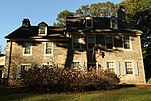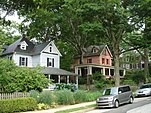Lynnewood Hall
| Lynnewood Hall | |
|---|---|
 Pictured in 2007 | |
 | |
| General information | |
| Architectural style | Neoclassical Revival |
| Address | 920 Spring Ave. |
| Town or city | Elkins Park, Pennsylvania |
| Country | USA |
| Coordinates | 40°4′30.67″N 75°8′27.01″W / 40.0751861°N 75.1408361°W |
| Construction started | 1897 |
| Completed | 1900 |
| Cost | $8 million (equivalent to $293 million in 2023) |
| Client | Peter A. B. Widener |
| Owner | Lynnewood Hall Preservation Foundation (purchased from First Korean Church of New York in 2023) |
| Height | 215 square feet (20.0 m2) |
| Dimensions | |
| Diameter | 325 square feet (30.2 m2) |
| Technical details | |
| Floor area | 110,000 square feet (10,000 m2) |
| Design and construction | |
| Architect(s) | Horace Trumbauer |
Lynnewood Hall is a 110-room Neoclassical Revival mansion in Elkins Park, Pennsylvania. Currently undergoing renovations[1] after sitting nearly vacant for years, it was designed by architect Horace Trumbauer for industrialist Peter A. B. Widener and built between 1897 and 1900. Considered the largest surviving Gilded Age mansion in the Philadelphia area, it housed one of the most important Gilded Age private art collections of European masterpieces and decorative arts, which had been assembled by Widener and his younger son, Joseph E. Widener.
Peter Widener died at Lynnewood Hall at the age of 80 on November 6, 1915, after prolonged poor health.[2] He was predeceased by his elder son George Dunton Widener and grandson Harry Elkins Widener, both of whom died when RMS Titanic sank in 1912. The structure changed hands a few times over the subsequent decades, with large portions of the estate grounds sold off in the 1940s, and has been predominantly vacant since 1952, when it was purchased by a Presbyterian seminary.
It is presently being renovated by the Lynnewood Hall Preservation Foundation, which announced a purchase agreement for the estate in February of 2023.[1]
Description[edit]
Built from Indiana limestone, the T-shaped Lynnewood Hall (dubbed "The last of the American Versailles" by Widener's grandson) measures 325 feet (99 m) long by 215 feet (66 m) deep.[3] In addition to 55 bedrooms, the 110-room mansion had a large art gallery, a ballroom large enough for 1,000 guests, swimming pool, wine cellars, a farm, carpentry and upholstery studios, and an electrical power plant. The estate originally encompassed 300 acres, upon 33 of which a fenced ornamental garden was constructed. The fenced area includes a gatehouse and smaller Lynnewood Lodge (also known as Conklin Hall), built in the same style as the mansion. The mansion's grounds have remained contiguous since the 1952 sale.[4]
A 2014 article in The Philadelphia Inquirer described the mansion as "dripping with silk, velvet, and gilded moldings, the rooms furnished with chairs from Louis XV's palace, Persian rugs, and Chinese pottery, the halls crammed with art by Raphael, Rembrandt, El Greco, van Dyck, Donatello."[5] TIME magazine published an account of a lavish party held at Lynnewood Hall in 1932.[6]
Art collection[edit]

From 1915 to 1940, the spectacular art collection at Lynnewood Hall was open to the public by appointment between June and October.
In 1942, Joseph E. Widener donated more than 2,000 sculptures, paintings, decorative art works, and porcelains to the National Gallery of Art. P.A.B. Widener had originally planned for the collection to go to the Philadelphia Museum of Art. The paintings included Raphael's Small Cowper Madonna, Bellini's The Feast of the Gods, eight van Dycks, two Vermeers, fourteen Rembrandts, and a series of portraits by Gainsborough and Reynolds.[7] The sculptures included Donatello's David and Desiderio da Settignano's St John the Baptist.[7][8]
History[edit]
Construction to sale[edit]

By the time Horace Trumbauer was commissioned by Peter A.B. Widener to build Lynnewood Hall, Trumbauer had already designed the Widener family's Philadelphia townhome and house in New York City. Trumbauer collaborated with the French firm Carlhian et Fils to design the mansion's interiors, utilizing large amounts of salvaged European furniture, tapestries, and rooms. The mansion's 18th-century ballroom, one of the largest on the eastern seaboard, was imported from Italy. Construction began in 1897, and the mansion was opened after only two years of construction with a gala held on December 19, 1899.
The mansion was built on a property of 300 acres, and its ornamental gardens, covering 33 acres, were originally fashioned by head gardener William Kleinheinz. The gardens included a large fountain by Henri-Léon Gréber, one of only two major surviving Gréber commissions in America.
Upon Peter A.B. Widener's death in 1915, the property passed to his son, Joseph. In 1916, the gardens were redesigned in the French style by Jacques Gréber, also master designer of the Benjamin Franklin Parkway and, later, the 1937 Paris Exhibition. Boasting stables, greenhouses, a polo field, and a reservoir, the estate employed a staff of 100 at its peak.[9]
Joseph's son, Peter A.B. Widener II, was a passionate dog breeder, constructing extensive kennels on the property starting in 1920. As a result, the grounds were used for training military dogs during World War II. Joseph Widener donated the estate's massive art collection to the National Gallery of Art in 1942, and upon his death one year later, and the southern part of the estate was sold for development in 1943.[10] The house, its gardens, and its outlying buildings were sold shortly afterwards to a private buyer who hoped to turn the property into a Protestant seminary, when this buyer defaulted on his $99,000 mortage, the property was temporarily repossessed by the Wideners. [11]
Lynnewood Hall was purchased in 1952 by Faith Theological Seminary, a Christian school of higher education headed by Carl McIntire. The purchase price was US$192,000 (equivalent to $2,200,000 in 2023).[12]
After sale[edit]
The Seminary trained hundreds of ministers and Christian leaders at Lynnewood Hall for over 40 years. As the Seminary began to experience financial difficulties, it dismantled large parts of the mansion's interior, selling off what was severable.[12] In 1996, the property was sold to the First Korean Church of New York, a Presbyterian-affiliated church with ties to Faith Theological Seminary, in a Sheriff's Sale. By the time of the property's purchase, all three of the remaining buildings on the property, Lynnewood Hall, Lynnewood Lodge, and the gatehouse, were in various states of dilapidation, with the gatehouse being fully abandoned. First Korean Church sought numerous times to turn the property back into a seminary and church, beginning in 1998, but failed to in a string of applications and lawsuits.
In 2006, in First Korean Church of N.Y., Inc. v. Montgomery Cnty. Bd. of Assessment Appeals, the court found that the property had not demonstrably been used for religious or educational purposes since 1998. The church continued to sell off remaining parts of the property. In 2006, Lynnewood Hall's Gréber fountain was sold at auction.[13]
After a final February 2012 ruling that First Korean Church did not qualify for a tax exemption, Dr. Richard S. Yoon, the church's President and pastor, gave an interview to the Philadelphia Inquirer where he stated his intent to finally relocate the church and end the legal battle.[4][14]
This property was on the market for $11,000,000[15] in May 2019. Despite multiple offers above the asking price, the home remained unsold.[16] A historical restoration architect estimated in 2014 that it would take about $50 million to restore the mansion to its former glory; however, Realtor Frank Johnson suggests the property could be renovated for $3 million to $8 million.[17]
On July 5, 2022, it was announced that Lynnewood Hall Preservation Foundation was established with the goal of acquiring "the Trumbauer-designed Widener Family Estate, a true architectural masterpiece, and see it restored to its former breathtaking glory."[18]
On February 8, 2023, a purchase agreement was announced for the property by the foundation, with plans for the restored gardens to be open to the public as a park, and to fully restore the hall.[1] On June 27, 2023, the mansion's sale was completed for $9 million, and ownership passed to the nonprofit Lynnewood Hall Preservation Foundation.[19][20]
A music video for the song "Come on Heartache" by the band The Menzingers was filmed onsite at Lynnewood Hall in September 2023.
References[edit]
- ^ a b c Robinson, Carla. "Purchase agreement reached for historic Lynnewood Hall: Pottstown investor funds Gilded Age mansion's preservation foundation". The Chestnut Hill Local. Retrieved February 9, 2023.
- ^ "P.A.B. Widener, Capitalist, Dies". The New York Times. November 7, 1915. Retrieved January 5, 2019.
- ^ "Peter A.B. Widener Dead". Boston Evening Transcript. November 6, 1915. Retrieved January 5, 2019 – via Google News Archive.
- ^ a b Court document, First Korean Church of New York, Inc. v. Cheltenham Township Zoning Hearing Board and Cheltenham Township, Doc. No. 65-6389, February 29, 2012.
- ^ Parks, Jessica (August 11, 2014). "The clock is ticking for Lynnewood Hall". The Philadelphia Inquirer.
- ^ "Business: Party at Lynnewood". Time. October 24, 1932 – via content.time.com.
- ^ a b Quodbach, Esmée (2002). ""The Last of the American Versailles": The Widener Collection at Lynnewood Hall". Simiolus: Netherlands Quarterly for the History of Art. 1/2 (1/2): 42–96. doi:10.2307/3780924. JSTOR 3780924.
- ^ "Provenance". www.nga.gov. Retrieved May 24, 2024.
- ^ "Bonhams : The magnificent and important Widener French patinated bronze figural fountain depicting Tritons and Nereids". www.bonhams.com. Retrieved May 24, 2024.
- ^ "Magnificent Fountain to be Featured During Second Annual Garden Sale at Bonhams & Butterfields in San Francisco". Bonhams. Archived from the original on March 8, 2012. Retrieved January 5, 2019.
- ^ "HISTORY". Lynnewood Hall Preservation Foundation, Inc. Retrieved May 24, 2024.
- ^ a b "Want to buy a haunted house? 'World's biggest ghost house' is up for sale in Pa. for $16M: report". pennlive. October 26, 2020.
- ^ "Bonhams : The magnificent and important Widener French patinated bronze figural fountain depicting Tritons and Nereids". www.bonhams.com.
- ^ Writer, By Jennifer Lin, Inquirer Staff (July 20, 2013). "'Last hope' for pastor's grand estate". https://www.inquirer.com. Retrieved May 24, 2024.
{{cite web}}: External link in|website= - ^ "A1 ASHBOURNE RD, Elkins Park PA 19027".
- ^ Elizabeth, Mary; riotis (September 9, 2021). "The Mysterious History of a $256 Million Mansion With Ties to the Titanic". House Beautiful. Retrieved September 20, 2021.
- ^ "Lynnewood Hall Renovation Costs". Realtor.com. Luke Stangel. May 30, 2017. Retrieved June 29, 2017.
- ^ Hass, Kimberly. "Preservation Group Mobilizes to Save Lynnewood Hall". Hidden City Philadelphia. Retrieved July 6, 2022.
- ^ Ladd, Jenn (June 30, 2023). "After almost a decade on the market, Lynnewood Hall in Elkins Park has been sold — and saved". Philadelphia Inquirer. Philadelphia, Pennsylvania.
- ^ "Montgomery County PA Property Records".
External links[edit]
- Lynnewood Hall Preservation Foundation
- Site dedicated to Lynnewood Hall and its preservation.
- Historical Information
- Historical aerial photos of the estate in the 1920s and 1930s
- "Lynnewood Hall" on YouTube (aerial video)
- Historic American Buildings Survey (HABS) No. PA-6146, "Lynnewood Hall, 920 Spring Avenue, Elkins Park, Montgomery County, PA", 9 photos, 9 data pages, 1 photo caption page




